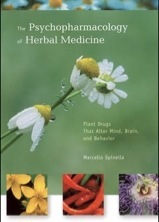Book Review






Marcello Spinella teaches at the Richard Stockton College of New Jersey, and he has written this book, and another entitled, ‘Concise Handbook of Psychoactive Drugs’. He has been studying the medical uses of alternative herbal medicines for his entire professional career, and this book, ‘The Psychopharmacology of Herbal Medicines’ was published in 2001.
The Psychopharmacology of Herbal Medicines is separated into 10 chapters. The first three are introductions to the specific neuroscience and pharmacology terminology used throughout the last seven chapters. An undergraduate studying a combination of chemistry and biology will find much of this a review, but someone who does not have a science related educational background will find this part of the book extremely necessary in understanding words, their acronyms, and uses. The style of the book is very dry, written more as a scientific reference textbook than an easy-reader.
The content in the first three chapters covers the uses, the appeals, implications, federal regulations, the evolution of herbal medicine, and clinical trials and evidence of herbal medicine. Next, the nervous system is explained, beginning first with the neuron, and then it moves onto explain things like action potentials and neurotransmitters. The third chapter breaks down the two main areas of pharmacology: pharmacokinetics and pharmacodynamics explaining how the body affects a drug and how a drug affects the body. Again, some of this will be extremely familiar for a biological or chemistry related undergraduate student, while clinical pharmacokinetics may have some definitions or terms that may not be familiar such as clearance rates or one-model compartments versus multiple-model compartments.
The next 7 chapters are called, ‘Stimulant Drugs’, ‘Cognitive Enhancers’, ‘Herbal Sedatives and Anxioltycs’, ‘Psychotherapeutic Herbs’, Analgesic and Anesthetic Plants’, ‘Hallucinogenic Plants’ and ‘Cannabis’. These chapters are written in a very professional manner, referencing clinical trials and articles frequently, and so people looking for information on abuse or recreational dosage will not find this book as useful. The uses of tables and figures are applied, however, one cannot look at just the figures and have a total grasp of the material covered in that specific chapter. This is more written to be a resource and a reference for the pharmacology of herbal medicine, however, there are very entertaining historical anecdotes and jeopardy facts that will trick your friends into thinking you know what you’re talking about. Lastly, level of scientific detail is suitable for any medical school student, however, anyone with an understanding for either the plant or the central nervous system will be able to read certain sections relatively easily.
The following is an overview of Chapters 4 – 10.
Chapter 4, ‘Stimulant Drugs’ gives a historical account, along with chemical constituents coffee, tea, cocoa guarana, tobacco, and more. General affects, toxicity reports, mechanisms of action, addiction/tolerance levels, and pharmacokinetics are a few of the many reports for the stimulants. Some have more information than others though, for example, a handful of pages are devoted to tobacco, whereas less than a page is used to talk about tea.
Chapter 5, ‘Cognitive Effects’ studies the applications of herbal alternative medicine for illnesses such as Alzheimer’s disease, peripheral vascular disease, hypertension, and many forms of dementia. Gingko, ginseng, ergot alkaloids (LSD-like compounds), tobacco, and a few others are described at length regarding their medical applications.
Chapter 6, ‘Herbal Sedatives and Anxiolyrics’ are used to treat insomnia, anxiety, but over dependence following treatment has always been a problem. Valerian and Kava are most discussed in this chapter as having anti-epileptic and anti-seizure qualities.
Chapter 7, ‘Psychotherapeutic Herbs’ have been practiced for years to treat mental illnesses, however, most are ineffective or impractical. Rauwolfia, hypericum, ginger and ginkgo all have antidepressant effects and are described at length in this chapter.
Chapter 8, ‘Analgesic and Anesthetic Plants’ covers herbal remedies that alleviate pain. Poppy, myrrh, tobacco, willow, chili, ginger, coffee, tea, chocolate, cannabis, coca, and ginseng are a handful of the many plants covered. As a coffee/tea drinker, I found the section of the stimulants having analgesic effects to be quite interesting.
Chapter 9, “Hallucinogenic Plants’ is exactly what you’re thinking of. It begins with a history of medical usage and overview of what hallucinogens are, and then gets into specifics with Ergot and LSD. The entire chapter is dedicated to hallucinogens of many kinds, and so this can be a very helpful chapter for you if you are looking for a scientific description and chemical breakdowns of these hallucinogens.
Chapter 10, ‘Cannabis’ is similar to Chapter 9, except it is about cannabis and its medicals uses.
The Psychopharmacology of Herbal Medications: Plant Drugs that Alter Mind, Brain and Behavior. Marcello Spinella. MIT Press, 2001.
US$24.95 (500 pages) ISBN: 026269265
“In 1997, 42% of people in a US National sample reported consulting at least one form of alternative medicine during the previous year, increasing from 33.8% in 1990.”
“Provides the reader with the essential background about psychoactive herbs. This is an outstanding summary that covers commonly used herbal supplements such as ginseng as well as the more exotic plant-based options such as hallucinogenic mushrooms.”
Edzard Ernst, MD, PhD
Monday, January 30, 2012



The Psychopharmacology of Herbal Medicine





